LAB REPORT
Science and Technology Making Headlines
June 14, 2019
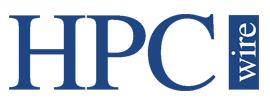
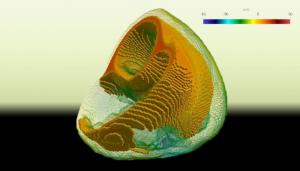
A still from a Cardioid simulation shows the electrical activation of the heart. The colors correspond to the voltage difference across the cardiac cell membrane. Nearby cells signal each other in a propagating electrical wave much like a nerve cell, allowing the heart to coordinate its contraction.
The heart of the matter
A Lawrence Livermore team has successfully optimized a code that models the human heartbeat for next-generation, graphics processing unit (GPU)-based supercomputers, with an eye on developing it for virtual drug screening and modeling heart activity in clinical settings.
Cardioid, a suite merging mathematical solvers for electrophysiology, fiber-generation, cardiac mechanics, torso-electrocardiograms (ECGs) and cardiac meshing tools, simulates the electrical current running through the heart tissue, triggering cells to contract like cascading dominoes and causing the heart to beat. It was originally developed by LLNL and IBM for the Sequoia supercomputer and was a finalist for the 2012 Gordon Bell Prize, supercomputing’s top honor.
When the code was originally developed it wasn’t portable to other computers. But the new work makes that possible by porting the code over to the heterogenous CPU/GPU systems that would displace Sequoia: Sierra and its unclassified counterpart, Lassen.

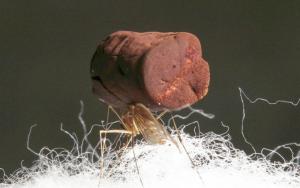
The ultra-low density gold, silver and copper foams are so tiny that they it can ride on a mosquito’s back. Pictured here is a mosquito standing on cotton fibers carrying a sample of the gold aerogel. Photo by Joshua DeOtte/LLNL
Good as gold but not as heavy
LLNL scientists have created ultra-low density gold, silver and copper foams to give physicists better X-ray sources to use in experiments at the National Ignition Facility.
This facility is a large laser-based inertial confinement fusion research device that uses lasers to heat and compress a small amount of hydrogen fuel with the goal of inducing nuclear fusion reactions.
“We are looking primarily at fundamental science questions that govern how to synthesize, assemble and shape metal nanowire-based aerogels,” said the project’s principal investigator, Michael Bagge-Hansen.
Bagge-Hansen explained that although the material is called foam, it is not made by foaming. Rather, it is a spaghetti-like web of randomly connected nanometer-sized wires, formed into the shape of a miniature marshmallows and containing the same or fewer number of atoms as air.

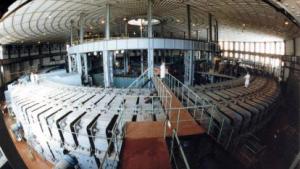
Accelerators like this one at the Joint Institute for Nuclear Research in Russia helps scientists discover new elements.
On the edge of the periodic table
The new book, “Superheavy: Making and Breaking the Periodic Table,” is about the discovery of elements beyond lawrencium.
In the book, author Kit Chapman starts a bit before the superheavy elements were discoverd, charting the course of modern element discovery and synthesis.
Like many books about science history, “Superheavy“ is as much about the people as it is about the science. And some of those people include the Lawrence Livermore team members who helped discover six new superheavy elements.
Chapman points out that scientific collaborations did occasionally cross otherwise impregnable political divides. In 1989, the directors of the Joint Institute for Nuclear Research in Russia and Lawrence Livermore agreed to work together to find the next superheavy elements. The Dubna-Livermore collaboration now claims the discovery of six elements, including the heaviest, oganesson.

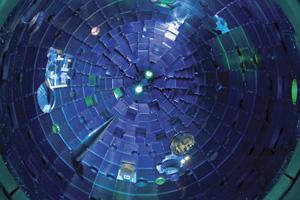
The National Ignition Facility’s 192-laser system set a record shot: 2.15 MJ.
Happy birthday, laser
In 2020, the laser will celebrate its 60th anniversary. Lawrence Livermore sits prominently on a timeline of some of the more notable scientific accomplishments related to light amplification by stimulated emission of radiation (laser).
In the early days, physicists John Emmett and John Nuckolls were the key Lawrence Livermore pioneers in laser and fusion science and technology. Emmett co-invented the multipass laser architecture still in use today.
By May 2009, the largest and highest-energy laser in the world, the National Ignition Facility (NIF) at Lawrence Livermore, was dedicated.
In January 2010, NIF successfully delivered a historic level of laser energy — more than 1 megajoule (MJ) — to a target in a few billionths of a second, and demonstrated the target drive conditions required to achieve fusion ignition, a project scheduled for the summer of 2010. The peak power of the laser light is about 500 times that used by the U.S. at any given time.
In July 2012, a new record was set: peak power in excess of 500 trillion watts. Delivered by 192 UV laser beams at NIF, the 1.85 MJ of energy struck a target that was just 2 mm in diameter.
In July 2018, the NIF laser system set a new record: 2.15 MJ. This was more than 10 percent higher than the previous record set in March 2012.

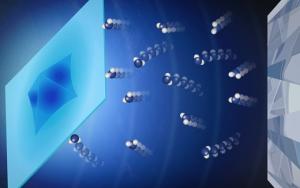
This illustration depicts the transition of ice growth by dynamic compression using the advanced dynamic diamond anvil cell, which enhances interface structure and leads fast interface kinetics of water-ice interface, initiating two-dimensional shock growth even near equilibrium melting pressure. Illustration by Yong-Jae Kim and James Wickboldt/LLNL
The view is crystal clear under pressure
Crystal growth is a crucial issue for fundamental science and wide applications. The growth morphology and speed are generally determined by an interplay between macroscopic thermodynamic driving forces and the microscopic kinetic process at crystal-liquid interface.
While crystal growth is well understood at near-equilibrium growth conditions, the growth transition with diverse growth morphologies are poorly understood under nonequilibrium growth conditions (e.g. dynamic compression).
A study recently published in the Proceedings of the National Academy of Sciences (PNAS) provides a new insight of crystal growth under dynamic compression using an advanced dynamic diamond anvil cell (dDAC) technique, which bridges the unknown behaviors of crystal growth between static and dynamic pressure conditions.
"Our study takes a step forward in better understanding and predicting crystal growth in the real world, from diverse snowflakes to planet interiors at extreme conditions," said co-lead author Yong-Jae Kim, a physicist at Lawrence Livermore.





